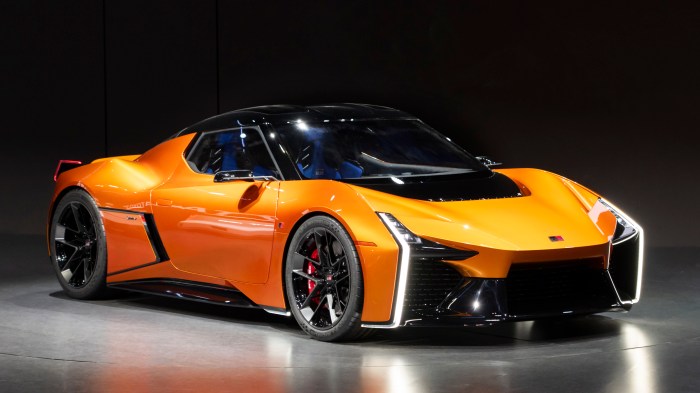Toyota Electric Sports Car: Imagine a future where exhilarating performance meets sustainable driving. This isn’t just about electric vehicles; it’s about redefining the sports car experience. We’ll explore Toyota’s ambitious EV strategy, examining its technological hurdles and innovative solutions, and envisioning what a Toyota electric sports car could truly offer.
Prepare for a deep dive into horsepower, torque, and a greener tomorrow.
This exploration covers everything from Toyota’s competitive landscape and battery technology to the design aesthetics and market positioning of a hypothetical electric sports car. We’ll analyze the potential performance specs, discuss the target audience, and even delve into the environmental impact of such a vehicle.
Get ready to experience the electrifying potential of Toyota’s future.
Environmental Impact and Sustainability
This section delves into the environmental advantages of Toyota’s electric sports car compared to its gasoline-powered counterparts, examining Toyota’s dedication to sustainable manufacturing, the life-cycle assessment of the battery, and strategies for minimizing the vehicle’s overall carbon footprint. We’ll explore the concrete steps taken to reduce the environmental impact across the entire lifespan of the vehicle, from production to disposal.The environmental benefits of an electric sports car are significant and multifaceted.
Unlike gasoline-powered vehicles, electric vehicles produce zero tailpipe emissions, drastically reducing air pollution in urban areas and contributing to cleaner air overall. This directly addresses concerns about respiratory health and climate change caused by greenhouse gas emissions from combustion engines.
Furthermore, the reliance on renewable energy sources to charge the vehicle’s battery further minimizes the environmental impact, creating a more sustainable transportation solution.
Toyota’s Commitment to Sustainable Manufacturing
Toyota is actively committed to minimizing the environmental impact of its electric vehicle production. This commitment extends across the entire supply chain, from sourcing raw materials responsibly to implementing energy-efficient manufacturing processes in its factories. The company invests heavily in renewable energy sources to power its facilities, reducing reliance on fossil fuels.
Furthermore, Toyota employs advanced recycling techniques to recover and reuse valuable materials from end-of-life vehicles, minimizing waste and conserving resources. For example, Toyota’s use of recycled aluminum in vehicle components demonstrates a concrete commitment to circular economy principles.
This closed-loop system significantly reduces the need for virgin materials, lessening the environmental burden associated with extraction and processing.
Battery Life-Cycle Assessment and Environmental Impact
The battery’s life cycle, encompassing its manufacturing, use, and disposal, is a crucial aspect of the overall environmental impact of an electric vehicle. The manufacturing process requires energy and resources, and the extraction of raw materials like lithium and cobalt can raise ethical and environmental concerns.
However, advancements in battery technology are continually improving energy density and extending lifespan, reducing the need for frequent replacements. Toyota is actively involved in research and development to improve battery recycling technologies, aiming to recover valuable materials and minimize waste sent to landfills.
The company’s strategy includes partnering with recycling companies and investing in innovative battery recycling processes to reclaim valuable metals and materials for reuse in new batteries or other applications. A thorough life-cycle assessment, considering all these factors, is critical for accurately evaluating the overall environmental footprint.
For example, studies comparing the lifecycle emissions of electric vehicles and gasoline vehicles often show that even considering battery production, the overall emissions are significantly lower for EVs, especially when charged with renewable energy.
Strategies for Minimizing Carbon Footprint, Toyota electric sports car
Minimizing the carbon footprint of the electric sports car involves a multi-pronged approach. This includes optimizing the vehicle’s design for energy efficiency, using recycled and sustainably sourced materials in its construction, and promoting the use of renewable energy for charging.
Toyota is investing in lightweight materials to reduce the vehicle’s weight, improving its energy efficiency and range. Furthermore, the company is exploring partnerships with renewable energy providers to encourage the use of clean energy for charging, further reducing the vehicle’s carbon footprint during its operational phase.
The use of carbon offsets, where investments are made in projects that reduce greenhouse gas emissions elsewhere, can also contribute to a net reduction in the vehicle’s environmental impact. These offset projects could include reforestation initiatives or investments in renewable energy infrastructure.
The overall strategy focuses on reducing emissions across the entire life cycle, from the sourcing of raw materials to the end-of-life management of the vehicle and its components.
Closure

The prospect of a Toyota electric sports car is more than just a technological advancement; it’s a statement. It represents a commitment to performance, sustainability, and innovation. While challenges remain, the potential rewards—a thrilling, eco-conscious driving experience—are immense.
The journey to this electric future is underway, and the destination promises to be electrifying.
Quick FAQs: Toyota Electric Sports Car
Will a Toyota electric sports car be affordable?
Pricing will depend on features and market competition, but Toyota aims for competitive pricing within the electric sports car segment.
What about charging infrastructure?
Toyota’s strategy includes investments in and partnerships to expand charging networks to support its EV rollout.
How will the battery life be affected by performance driving?
Aggressive driving will naturally reduce range, but advanced battery management systems will mitigate this impact.
What kind of safety features can we expect?
Expect advanced driver-assistance systems (ADAS) like lane keeping assist, adaptive cruise control, and automatic emergency braking, alongside other safety features typical of modern vehicles.